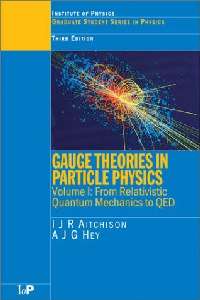| Gauge Theories in Particle Physics: A Practical Introduction - From Relativistic Quantum Mechanics to Qed (Graduate Student Series in Physics) (2002) |
| Plot |
| Contents 1 Quarks and Leptons.2 Particle Interactions in the Standard Mode.3 Electromagnetism as a Gauge Theory.4 Relativistic Quantum Mechanics.5 Quantum Field Theory I.6 Quantum Field Theory II: Interacting Scalar Fields.7 Quantum Field Theory III: Complex Scalar Fields, Dirac and Maxwell fields; Introduction of Electromagnetism.8 Elementary Processes in Scalara and Spinor Electrodynamics.9 Deep Inelastic Electron-nucleon Scattering and the Quark Parton Model.10 Higher Order Processes and Renormalisation. 11 Appendices.Index Synopsis This book provides an accessible, practical and comprehensive introduction to the three gauge theories of the 'standard model' of particle physics: quantum electrodynamics (QED), quantum chromodynamics (QCD) and the electroweak theory. For each of them, the authors provide a thorough discussion of the main conceptual points; a detailed exposition of many practical calculations of physical quantities; and a comparison of these quantitative predictions with experimental results. For this two-volume third edition, much of the book has been re-written to reflect developments over the last decade, both in the curricula of university courses, and in particle physics research. On the one hand, substantial new material has been introduced which is intended for use in undergraduate physics courses. New introductory chapters provide a precise historical account of the properties of quarks and leptons, and a qualitative overview of the quantum field description of their interactions, at a level appropriate to third year courses. The chapter on relativistic quantum mechanics has been enlarged and is supplemented by additional sections on scattering theory and Green functions, in a form appropriate to fourth year courses. On the other hand, since precision experiments now test the theories beyond lowest order in perturbation theory, an understanding of the data requires a more sophisticated knowledge of quantum field theory, including ideas of renormalisation. The treatment of quantum field theory has therefore been considerably extended so as to provide a uniquely accessible and self-contained introduction to quantum field dynamics, as described by Feynman graphs. The level is suitable for advanced fourth year undergraduates and first year graduates. These developments are all contained in the first volume, which ends with a discussion of higher order corrections in QED; the second volume is devoted to the non-Abelian gauge theories of QCD and the electroweak theory. As in the first two editions, emphasis is placed throughout on developing realistic calculations from a secure physical and conceptual basis. Readership Graduate and senior undergraduate students taking courses on the standard model of particle physics. Postgraduate students and researchers in particle physics. |
|
|
||||||||||||||||||||||||||||||
